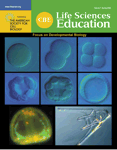A Western Blot-based Investigation of the Yeast Secretory Pathway Designed for an Intermediate-Level Undergraduate Cell Biology Laboratory
Abstract
The movement of newly synthesized proteins through the endomembrane system of eukaryotic cells, often referred to generally as the secretory pathway, is a topic covered in most intermediate-level undergraduate cell biology courses. An article previously published in this journal described a laboratory exercise in which yeast mutants defective in two distinct steps of protein secretion were differentiated using a genetic reporter designed specifically to identify defects in the first step of the pathway, the insertion of proteins into the endoplasmic reticulum (Vallen, 2002). We have developed two versions of a Western blotting assay that serves as a second way of distinguishing the two secretory mutants, which we pair with the genetic assay in a 3-wk laboratory module. A quiz administered before and after students participated in the lab activities revealed significant postlab gains in their understanding of the secretory pathway and experimental techniques used to study it. A second survey administered at the end of the lab module assessed student perceptions of the efficacy of the lab activities; the results of this survey indicated that the experiments were successful in meeting a set of educational goals defined by the instructor.



